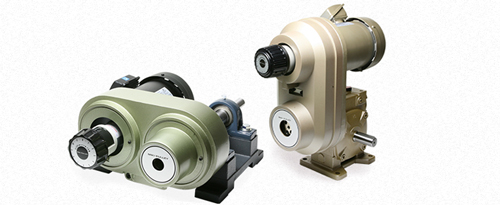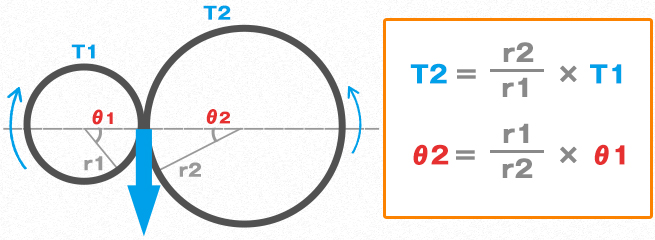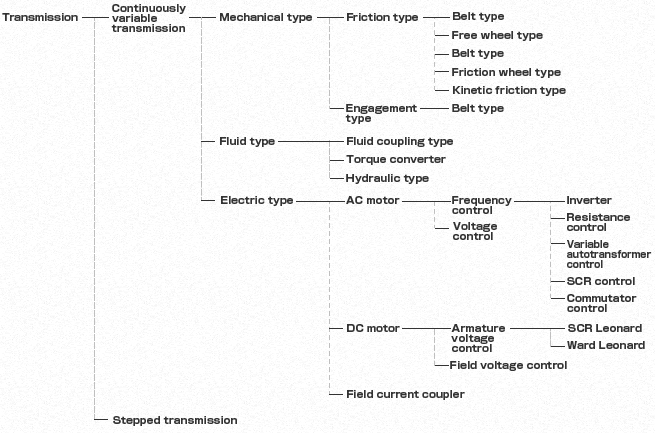What Are Transmissions and Speed Reducers? Their Types and Structures
What Are Transmissions and Speed Reducers?
Speed reducers are devices that decelerate and output the rotational speed with gears and similar. They can output torque inversely proportional to the deceleration.
Transmissions are devices that change the ratio of the rotational speed. Transmissions can change the speed in contrast to speed reducers which have a constant speed.

Index
Why Are Transmissions and Speed Reducers Necessary?
Transmissions and speed reducers are used to change or decelerate the power obtained from a power source (e.g., motor). Why are transmissions and speed reducers necessary? We need to have a little understanding of motors to grasp that.
Various types of motor are used in industrial machinery and devices. However, the most commonly and widely used motor is one called a three-phase induction motor. This motor is made to operate with a system called a three-phase AC power supply.
The power frequency determines how many times the motor rotates per minute.
Let’s think about a situation in which products are actually moving on a conveyor belt in a factory. If the conveyor belt operated at the aforementioned rotational speed of the motor, it would operate at an incredible speed and it would be out of control. Accordingly, the rotational speed is changed or reduced with a transmission or a speed reducer to obtain the required rotational speed. In other words, transmissions and speed reducers are necessary to the extent that we can say they must be used when using power obtained from a motor.
It is possible to obtain the motor rotational speed from the following formula.
・Motor rotational speed:
N = 60 × Frequency [Hz] / Number of poles / 2[min-1]
- Summary: Roles of Transmissions and Speed Reducers 1
- ・Transmissions and speed reducers change and decelerate
the rotational speed of motors.
Principles of Changing and Decelerating Speed
We stated that transmissions and speed reducers are devices that obtain the required rotational speed. However, they have one more important role. That is that they obtain a rotational force (torque) proportional to the deceleration ratio.
For example, if we halve the rotational speed, that rotational force (torque) will double. This is because the mechanism of changing and decelerating speed uses the principle of leverage.

The above figure shows the principle of leverage. The formula in the above figure demonstrates that a large force called F2 can be obtained with the force of F1.
ition, we can see that the movement distance of L2 is shorter than the movement distance of L1. We get the following if we illustrate this by replacing this principle with an easy-to-understand rotating body. Accordingly, it is possible to increase the rotational force by lowering the rotational speed.

- Summary: Roles of Transmissions and Speed Reducers 2
- ・Transmissions and speed reducers can obtain a rotational force (torque)
proportional to the deceleration ratio.
Differences between Transmissions and Speed Reducers
Both transmissions and speed reducers are designed to decelerate the rotational speed of motors to obtain the required power. However, the main difference between them is that transmissions can change the speed while speed reducers have a constant speed. We can say that one of the best ways to extract power is a method of usage in which a speed reducer greatly decelerates the speed and a transmission then adjusts that speed.
- Summary: Roles and Differences between
Transmissions and Speed Reducers - ・Speed reducers rotate at a constant speed,
but transmissions can change the rotational speed.
Types and Structures of Speed Reducers
It is comparatively easy to realize the deceleration mechanism by combining spur gears with different numbers of teeth. Nevertheless, it is common to use one that has been turned into a device as a speed reducer. We give the systems below as typical speed reducers. However, it is common to combine the gears given below to realize a speed reducer to ensure the required deceleration ratio.
| Types | Characteristics |
|---|---|
| Parallel Axis Gear Speed Reducer | This is a speed reducer combined with a spur gear. It is available in one to four stages depending on the deceleration ratio. Power is transmitted with rolling. Therefore, it is possible to secure a transmission efficiency of about 98% per stage. The deceleration ratio is about 1/5 to 1/2,500 and can cover a wide range of deceleration ratios. There are differences in the number of gear stages combined with the deceleration ratio. This means that the dimensions of the speed reducer change depending on the adaptive motor output. |
| Helical Speed Reducer | This is the same as a parallel axis gear speed reducer, but it uses helical gears as its gears. Helical gears are those with a twisted tooth trace. As a result, the tooth engagement rate improves. This means that it is possible to obtain power transmission with a high degree of smoothness and quietness. However, they have a weak point. They generate thrust in proportion to the magnitude of the power transmission. This is because the tooth trace is smooth. It is possible to overcome this weak point with a double helical gear configured with an opposite helical gear to counteract this thrust force. |
| Bevel Gear Speed Reducer | This is a speed reducer combined with a bevel gear. A typical gear angle is 90°. Combining small and large gears leads to a deceleration in speed. However, these are often used to output with a 90° swing. To that end, it is also called a miter gear if the deceleration ratio is 1:1 among bevel speed reducers. Those that improve the engagement ratio by twisting the tooth trace of the bevel gears like helical gears are called spiral bevel gears. |
| Hypoid Speed Reducer | This is a gear laid out to offset the center of a pinion gear axis just be a certain amount with respect to the center of the gear axis. These add slip to the power transmission of spiral bevel gears like the worm speed reducer we describe later. This makes smoother power transmission possible. Hypoid speed reducers can obtain a large deceleration ratio. This is because the gear ratio is large like that of a worm speed reducer. Nevertheless, the engagement is complicated. Therefore, it is necessary to precisely adjust the engagement position. |
| Worm Speed Reducer | This is a speed reducer that combines a worm gear and a worm wheel. It is possible to obtain a large deceleration ratio of about 1/10 to 1/60 just with this combination. If the lead angle of the worm gear becomes smaller (higher deceleration ratio), it is called a self-lock. It is possible to use this to prevent lifting devices falling by utilizing the fact it is difficult to rotate from the worm wheel side (output side). In addition, reducing the thrust backlash of the input axis makes it possible to suppress the backlash. Accordingly, this is a speed reducer with various advantages. Nevertheless, power is transmitted according to the sliding of the tooth surface compared to spur gears. Consequently, heat is easily generated and the transfer efficiency is not very good at about 50%. |
Types of Transmission
When handling objects with different shapes, sizes and weights in operating a device, handling that device only at a certain speed may significantly reduce efficiency.
Accordingly, the operation efficiency improves if one device can operate at various speeds. For example, if is determined that two types of speed are necessary, it is best if two types of speed can be output.
The method for this is to produce speed by using a stepped transmission mechanism to switch with the clutch or to stop and switch the machine with respect to two types of output.
Nevertheless, more than that, it is overwhelmingly more convenient and efficient if it is possible to adjust the output speed without steps and without stopping the motor.
This is a step-less transmission for stepped transmissions in the category called transmissions.

*The above classifications also include speed change methods that are rarely used at present.
Miki Pulley also currently handles the classifications below as continuously variable transmissions.

Changing the frequency of a three-phase induction motor changes the speed. We separately summarize the electrical system for DC motors that are not three-phase induction motors. We summarize here the types and principles of belt type continuously variable transmissions that use the variable pitch pulleys which are a part of our company’s name.
Types and Structures of Belt Type Continuously Variable Transmissions
If we divide the transmission of power to the driven unit (machine) from the drive (motor), the common method is to wind with a gear, chain sprocket and belt pulley like a coupling or speed reducer that directly conveys the output of the motor. The pitch diameter of the belt is fixed in place with the power transmission of ordinary belt pulleys. Therefore, a constant speed is obtained by making a selection in advance to obtain the required rotational speed and rotational force.
Belt type continuously variable transmissions are continuously variable transmission that use belt pulleys. They change the input of constant rotation by changing the pitch diameter of the pulley on which the belt hangs. There are three broad types of system for this method of changing speed.

| Types | Characteristics |
|---|---|
| Intermediate Variable Pitch Type | The intermediate variable pitch type transmission is laid out between the drive and the driven unit. The speed is then changed by moving the intermediate variable pitch type pulley to the drive side and the driven side. The intermediate variable pitch type pulley is one with two V-shaped grooves. The pulley surface in the middle moves freely in the direction of the axis. Connecting one of the two V-shaped grooves to the drive side and the other to the driven side allows the intermediate vehicle type transmission to move with the position of the drive and the driven unit still fixed in place. This changes the driven and driven belt pitch diameter to change the speed. It has been designed with the adoption of the standard V belt that have good availability. Therefore, maintenance is easy and it is possible to realize a speed change mechanism that keeps down costs by realizing a speed change function with only a pulley in the intermediate layout. Nevertheless, it is necessary to install it between the drive and the driven unit and move both. Accordingly, if the distance between the axes increases to a certain extent, it may lead to the device becoming larger. L Models・U Models・T Models |
| Single Variable Pitch Type | A fixed pitch pully is laid out on the driven unit side and a single variable pitch type pulley is laid out on the drive side. The drive is then moved to change the distance between the axes. This changes the speed. Force attempting to close the pully is always applied with a spring built into single variable pitch type pulleys. Accordingly, widening the distance between the axes leads to the belt extending the pulley spring. This changes the pitch diameter to change the speed. There is a model that has adopted the standard V belt with good availability and a model that has adopted a transmission belt with high transmission capabilities. Both are suitable when the transmission ratio is relatively small. Moreover, a device to move the drive (motor) is required separately. > P Models・PL Models(Standard V Belt) > PK Models・PF Models(Wide Speed-change Belts) > R Models・RK Models・RH Models(Motor Slide Bases) |
| Double Variable Pitch Type | The aforementioned single variable pitch pulley is laid out on the driven side. A pulley that can forcibly open/shut the pulley is laid out on the drive side to change the speed. A rotating handle is set up on the pulley on the drive side. The pulley surface is then opened and closed with a feed screw. Force attempting to close is always applied with a spring built into the pulley on the driven unit side. Accordingly, manually rotating the handle of the pulley on the drive side changes the pulley pitch diameter on both the drive and driven unit sides. This leads to a change in speed without changing the distance between the axes. There is a model that has adopted the standard V belt with good availability and a model that has adopted a transmission belt with high transmission capabilities. These obtain a relatively large transmission ratio. Furthermore, there is no need to move the distance between the axes. Therefore, it is possible to provide this as a unit integrated with a motor, speed reducer or similar. >PSS Models(Standard V Belt)、AP Models+P Models > ANS Models・PDS Models・AHS Models(Wide Speed-change Belts)、AK Models+PE Models > PDC Models・PDG Models・PDV Models・ANW Models・ANG Models・ACW Models・ANB Models・ANV Models、AHM Models(Belt-type Stepless Speed Changer Units) |
 日本語
日本語 English
English Deutsch
Deutsch 中文
中文 한국어
한국어






